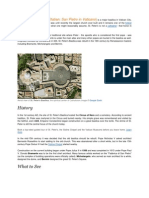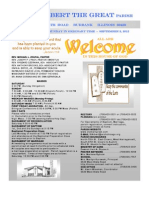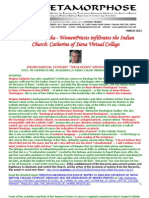Welcome To The Cistercian Abbey of Heiligenkreuz!: History Courtyard
Welcome To The Cistercian Abbey of Heiligenkreuz!: History Courtyard
Uploaded by
vivaCopyright:
Available Formats
Welcome To The Cistercian Abbey of Heiligenkreuz!: History Courtyard
Welcome To The Cistercian Abbey of Heiligenkreuz!: History Courtyard
Uploaded by
vivaOriginal Description:
Original Title
Copyright
Available Formats
Share this document
Did you find this document useful?
Is this content inappropriate?
Copyright:
Available Formats
Welcome To The Cistercian Abbey of Heiligenkreuz!: History Courtyard
Welcome To The Cistercian Abbey of Heiligenkreuz!: History Courtyard
Uploaded by
vivaCopyright:
Available Formats
Welcome to the Cistercian Abbey of Heiligenkreuz!
History
Courtyard
Heiligenkreuz Abbey in the Wienerwald was
founded in 1133 by St. Leopold III of the House
of Babenberg. Leopolds son, Otto, had been sent
to Paris to obtain an
international education. In
Paris, Otto came in
contact with Cistercian
monks and soon
decided to enter
a Cistercian
monastery.
When Otto
visited
his
father
in
Austria,
he asked
him to build
a similar
monastery
for Lower
Austria. This
was the reason
why St. Leopold
built
Heiligenkreuz; he
also founded
Klosterneuburg (in the northwest of Vienna).
Here you will find two monuments by Giovanni
Giuliani, an artist deeply connected to Heiligenkreuz. The Holy Trinity Column stands in the centre of the courtyard; St. Joseph's
Fountain is on the far side. Both were
made at the beginning of the 18th
Century. The Holy Trinity Column shows
the Assumption of the Virgin Mary (you
can see her rising, in the middle of
the column); the smaller panels
around St. Joseph's Fountain
show scenes from the
Bible.
1.
2.
3.
4.
5.
6.
7.
8.
9.
10.
11.
12.
13.
14.
15.
16.
17.
18.
19.
20.
21.
Reception and Visitor Information
Aula: Meeting Point for guided tours
Romanesque western facade of the
church (1187)
Column of The Holy Trinity (17291739)
Fountain of St. Joseph (1739)
Old Cloister Entrance (1730)
Cloister (1240)
Chapel of St. Anne (1710)
Chapterhouse (1240)
Funeral Chapel (1711)
Fountain House (1295)
Fraterie - Medieval Workroom (1240)
Sacristy (1667)
Apse in form of a hall (1295)
Nave (1187)
Living quarters of the monks (1642)
Chapel of St. Bernard (1295)
Festival Hall (1691)
Bell Tower (1674)
Sanctuary of the Relic of the Holy
Cross (1982)
Gift Shop
Cloister
The cloister
was
constructed
between
1220 and
1240: this was
a time of
stylistic transition from
Romanesque to
Gothic. Therefore,
you can find a
combination of the
two styles
here in the cloister.
Compare, for instance, the arches which connect
the small red marble columns.
Originally, the cloister was built as a connection
between the church and the sacristy. The monks
also used it for prayer and study.
The tombstones on the wall belong to members
of noble families who gave endowments to the
abbey. The oldest ones are from the 14th Century.
Statues
Two statues in the cloister are works by Giovanni
Giuliani. One depicts Jesus washing the feet of
St. Peter and the statue on the other side shows
Mary Magdalene anointing the feet of Jesus.
Made of linden wood, they were finished in 1705.
Reading Corridor
Every evening at eight o'clock, the monks convene here to read a chapter from the Rule of St.
Benedict. Every year on Holy Thursday, a foot
washing ceremony takes place here. As an imitation of Christs humility, the abbot washes the
feet of the 12 oldest men from parishes under
Heiligenkreuzs pastoral care.
The lower windows are all modern, but in the
semi-circular windows over the reading-pulpit
you can see original glass from the 13th Century;
these sections are light grey. The windows consist of glass and lead. The first Cistercians did not
use any colours in their stained glass, because
they wanted the windows to represent the simple
life.
St. Annes Chapel
Originally the front part of this room was the sacristy and the far end was the library. Later, when
the number of monks grew to 250, they needed a
new sacristy and a new library. Today, 64 monks
belong to the abbey. Not all of them live here,
because some of the monks have to take care of
the 17 parishes which belong to the monastery.
The Cistercian Order is a reform movement
within the Benedictine tradition. The Cistercians
split off in 1098 because they wanted to live in a
more simple way than the Benedictines.
Chapterhouse
The election of the abbot and the investiture of
novices take place in this room.
All the paintings are Baroque; those on the ceiling are by Michael Rottmayer, those on the wall
were made by a lay brother called Mathias Gusner. He painted the members of the House of
Babenberg who are buried here. The Romanesque, sculptured tombstone in the middle of the
room is the grave of the last Babenberg Duke,
Frederick the Quarrelsome; he died in 1246. The
windows were made in the 19th Century in Kramsach in Tyrol. The rosette-window was at the
World Exhibition in Paris in 1889, where it won
the first prize for its colours and their composition.
Funeral Chapel
Originally, this room was the Parlatorium, the
only room in the monastery where the monks
were allowed to speak. Later, the rule of silence
was limited to the night-time hours and therefore
Giovanni Giuliani transformed this room into a
chapel for the dead. Deceased monks were and
still are kept here for a 24-hour vigil before
being buried. The cross, made of lead, is by
Raphael Donner. The ugly window was created by
Peter Bischof in 1960.
Fountain House
This room served as a washing room till the middle of the 16th Century. The fountain was made in
Rome in 1556 and consists of five lead basins.
Because of the high mineral content of the water,
the fountain has been decorated by mineral
deposits. Most of the windows are modern replacements, but the one on the left that portrays
human figures originates from 1295. On the upper left side you can see the abbeys of Heiligenkreuz (left), and Klosterneuburg (right). Then,
underneath the two abbeys, you have pictures of
the man who founded both monasteries, St. Leopold III (left), and his wife Agnes (right). Under
the couple you can see six of their children. The
man in the white robe is Blessed Otto of Freising,
the son who was sent to Paris for college and
returned to Lower Austria with Cistercian monks.
Fraterie
Originally, this was the monks workroom, used
for making shoes and boots. The dark, grey spots
on the walls and on the ceiling are remnants from
13th-century paintings. They were discovered
recently during a restoration project. These
paintings are, like the windows in the cloister,
very straightforward: the monks only used two
colours (red and white) and they painted single
bricks in order to reflect their ideal of simplicity.
Sacristy
The sacristy was constructed at the beginning of
the 18th Century. The paintings and the frescos
on the ceiling, made by Grophoro Tenckalla and
Antonio Aliprandi, originated at the time of construction. The inlaid woodwork in the cabinets
was done by two lay brothers: Brother Lukas
Barth and Brother Casper Wiler. It took them 20
years to complete! In addition, they used 20 different kinds of wood: mainly maple, nut and linden wood.
Abbey Church
The Abbey Church was built in two different
styles: the Romanesque and the Gothic style.
The Romanesque part was finished in 1187. The
three windows above the entrance are typical of
Cistercian abbeys: they symbolise the Holy Trinity. The Gothic part of the church was finished in
1295. The high altar stands in the middle of this
part, over it a canopy and a painted wooden
cross. The altar and the canopy are Neogothic;
they are about 100 years old. The cross was
painted in 1980. It is the copy of an Italian original from 1138, found in a church next to La Spezia. The organ is one of the biggest musical instruments in Austria and was built in 1804. It has
3700 pipes, 50 registers and 2 manuals. Franz
Schubert and Anton Bruckner played it. Since
Schubert composed a special piece of music for
the organ, it is still called the Schubertorgan. The
choir stalls, which were created between 1708
and 1712, are another work by Giuliani. They
consist of nut wood (the dark parts) and linden
wood (the reliefs and busts above). The reliefs
portray scenes from the life of Jesus Christ. The
busts above represent saintly bishops, abbots
and statesmen. From their heavenly choir, they
join their voices in praise together with the
monks choir here below.
Today, the monks sing the office in Gregorian
Chant five times a day. Prayers begin here at
5:15 a.m. and end at 8:00 p.m.
Information: www.stift-heiligenkreuz.at
Address : Zisterzienserabtei Stift Heiligenkreuz, A-2532 Heiligenkreuz im Wienerwald,
Tel. +43-2258-8703-0; Email:
information@stift-heiligenkreuz.at
You might also like
- Likes and Dislikes of The DevilDocument4 pagesLikes and Dislikes of The DevilJoseph Dwight100% (4)
- 666Document13 pages666Riko Sempio-MercadoNo ratings yet
- 2Document49 pages2Gayatrimone100% (1)
- Notre Dam Paris PDFDocument5 pagesNotre Dam Paris PDFDusan AleksicNo ratings yet
- The Holy See: A Kid's Guide to Exploring the Vatican City - Geography Book Grade 6 | Children's Geography & Culture BooksFrom EverandThe Holy See: A Kid's Guide to Exploring the Vatican City - Geography Book Grade 6 | Children's Geography & Culture BooksRating: 5 out of 5 stars5/5 (1)
- 62 of The Worlds Most Beautifull World LibrariesDocument59 pages62 of The Worlds Most Beautifull World Librariesandrespernia100% (2)
- Wedding Music - ByzantineDocument40 pagesWedding Music - ByzantineHieromonk EphraimNo ratings yet
- Košice: St. Elisabeth's CathedralDocument11 pagesKošice: St. Elisabeth's CathedralmoljkaNo ratings yet
- Church and Convent of La Merced (Our Lady of Mercy) : CloisterDocument2 pagesChurch and Convent of La Merced (Our Lady of Mercy) : Cloisterjesu4197No ratings yet
- Practical 6 Word 2020-21 Without FormatDocument4 pagesPractical 6 Word 2020-21 Without FormatJuan LinNo ratings yet
- St. Peter's Basilica, RomeDocument21 pagesSt. Peter's Basilica, RomeManh ThangNo ratings yet
- Miziolek The Bishop Piotr Tomicki Chapel in Cracow Cathedral 2002Document10 pagesMiziolek The Bishop Piotr Tomicki Chapel in Cracow Cathedral 2002Boris Vučić-ŠnepergerNo ratings yet
- Sistine Chapel 1Document30 pagesSistine Chapel 19tami SolankiNo ratings yet
- Rabat - Environmental StudiesDocument19 pagesRabat - Environmental StudiesMarilyn CamenzuliNo ratings yet
- Basilica of The Holy BloodDocument13 pagesBasilica of The Holy BloodVioleta TaniNo ratings yet
- Sacral Relics in and Around GyőrDocument6 pagesSacral Relics in and Around GyőrEszter Tibolt-VassNo ratings yet
- Benedictine Nunnery of STDocument2 pagesBenedictine Nunnery of STKristijan MarićNo ratings yet
- French Arcitechure Eg in Pondicherry InfoDocument17 pagesFrench Arcitechure Eg in Pondicherry InfoTishya PansariNo ratings yet
- Ancient LvivDocument4 pagesAncient LvivIrene BrukhalNo ratings yet
- Ficuzza: A Fig Tree That Was Born From That Has Been Magically ReproducingDocument35 pagesFicuzza: A Fig Tree That Was Born From That Has Been Magically Reproducingvoglia100% (1)
- Zurich Attractions+alps PDFDocument24 pagesZurich Attractions+alps PDFashutsNo ratings yet
- 009-Santa Maria in TrastevereDocument16 pages009-Santa Maria in TrastevereRoger SanNo ratings yet
- Art Criticism 124 BlogDocument2 pagesArt Criticism 124 BlogChantriaNo ratings yet
- Santa Ana Church (Manila)Document5 pagesSanta Ana Church (Manila)Jason TiongcoNo ratings yet
- History: Cathedral, Is AnDocument5 pagesHistory: Cathedral, Is AnMukundNo ratings yet
- Catedral de GironaDocument10 pagesCatedral de GironaQueralt Boixadé PalahíNo ratings yet
- Witnesses To The Lutheran Faith in Bratislava: Janka KrivosováDocument19 pagesWitnesses To The Lutheran Faith in Bratislava: Janka KrivosováYosueNo ratings yet
- St. Peter's BasilicaDocument5 pagesSt. Peter's BasilicaEarl UbiñaNo ratings yet
- Brecon Cathedral: An Illustrated GuideDocument54 pagesBrecon Cathedral: An Illustrated Guidejohnpollard5100% (1)
- Ravenna: World HeritageDocument10 pagesRavenna: World HeritageR100% (1)
- Kościoły I Monastery W GruzjiDocument17 pagesKościoły I Monastery W GruzjiAlbert KarwaszNo ratings yet
- Renaissance Architecuure in Italy (Autosaved)Document25 pagesRenaissance Architecuure in Italy (Autosaved)preetiNo ratings yet
- Buddhist Chaitas and ViharasDocument25 pagesBuddhist Chaitas and ViharasSumit SharmaNo ratings yet
- DaphniDocument5 pagesDaphniGiorgosNo ratings yet
- Pisacathedralcomplexnew 230120113101 d5c8d7ffDocument19 pagesPisacathedralcomplexnew 230120113101 d5c8d7ffAde Iqbal PradhanaNo ratings yet
- Christian SymbolismDocument295 pagesChristian Symbolismportais100% (8)
- Cappella Di Sant' AnelloDocument3 pagesCappella Di Sant' AnelloDesideriusBTNo ratings yet
- ST Pauls Cathedral LondonDocument7 pagesST Pauls Cathedral LondonTed Kami-samaNo ratings yet
- Monastery of Agios Ioannis Lampadistis Afigisi enDocument11 pagesMonastery of Agios Ioannis Lampadistis Afigisi enAdolfo ReyNo ratings yet
- Church Furniture in Medieval English and Welsh Parish ChurchesDocument32 pagesChurch Furniture in Medieval English and Welsh Parish ChurchesAndrei ZamfirNo ratings yet
- Cathedral of Saint Pierre: The Chapel of The MaccabeansDocument6 pagesCathedral of Saint Pierre: The Chapel of The MaccabeansMaria MargiolouNo ratings yet
- New Liturgical Movement - Raphael in The Sistine Chapel - A Unique Exhibition in LondonDocument12 pagesNew Liturgical Movement - Raphael in The Sistine Chapel - A Unique Exhibition in Londonr_i_f_f_oNo ratings yet
- Santa MonicaDocument3 pagesSanta MonicaNaomi S. Ramos V.No ratings yet
- About Pisa CathedralDocument5 pagesAbout Pisa CathedralSnow WhiteNo ratings yet
- Valencia Lección CLILDocument13 pagesValencia Lección CLILsolNo ratings yet
- Medieval Architecture and LandscapesDocument26 pagesMedieval Architecture and LandscapesConstanza RivanoNo ratings yet
- The Church of Romanian Orthodox ParishDocument4 pagesThe Church of Romanian Orthodox Parishdariusvalentin13No ratings yet
- 1023 3627 1 PBDocument7 pages1023 3627 1 PBGiorgia CarcaniNo ratings yet
- Saint Peter BasilicaDocument2 pagesSaint Peter BasilicaSanic BardNo ratings yet
- Saxon Village RomaniaDocument7 pagesSaxon Village Romania12345zolyNo ratings yet
- Basilica of Saint Paul Outside The WallsDocument6 pagesBasilica of Saint Paul Outside The WallsJason TiongcoNo ratings yet
- Art Orientation CH 15 9th Ed OnlineDocument48 pagesArt Orientation CH 15 9th Ed OnlineNguyễn Đức ÝNo ratings yet
- Roman ArtDocument13 pagesRoman ArtDwardita Heisulher100% (1)
- Chiesa S.Caterina D'alessandria PDF TradottoDocument5 pagesChiesa S.Caterina D'alessandria PDF TradottoSalvatore EtiopiaNo ratings yet
- 10 MedievalDocument55 pages10 MedievalErika Mae LibangNo ratings yet
- Church and Convent of San Francisco (Saint Francis)Document1 pageChurch and Convent of San Francisco (Saint Francis)jesu4197No ratings yet
- Best Renaissance Buildings in Rome, ItalyDocument6 pagesBest Renaissance Buildings in Rome, ItalyDumb CoffeeNo ratings yet
- First Things First 4-24-25-10Document12 pagesFirst Things First 4-24-25-10val18879No ratings yet
- September 2, 2012Document6 pagesSeptember 2, 2012stalbertthegreatNo ratings yet
- Adventist HeroesDocument1 pageAdventist HeroesdsbabyNo ratings yet
- St. Athanasius and Divine ParticipationDocument6 pagesSt. Athanasius and Divine ParticipationDimmitri ChristouNo ratings yet
- Vatican Internal Abuse DocumentDocument73 pagesVatican Internal Abuse DocumentMalachy BrowneNo ratings yet
- Virginia Saldanha-Womenpriests Infiltrates The Indian Church-Catherine of Siena Virtual CollegeDocument70 pagesVirginia Saldanha-Womenpriests Infiltrates The Indian Church-Catherine of Siena Virtual CollegeFrancis LoboNo ratings yet
- ConantDocument232 pagesConanthelenaanjosNo ratings yet
- Modern English in The MakingDocument6 pagesModern English in The MakingNathan CadavidoNo ratings yet
- Anglicanism Sem 2Document19 pagesAnglicanism Sem 2JOSEPH MWANGINo ratings yet
- Gelpi The Firstborn of Many Doctrinal and Practical Christology Marquette Studies in Theology 20Document585 pagesGelpi The Firstborn of Many Doctrinal and Practical Christology Marquette Studies in Theology 20Jiu XingNo ratings yet
- The Millerton News - January 23, 2020Document12 pagesThe Millerton News - January 23, 2020Lakeville JournalNo ratings yet
- Chleit and Clachan Church Records - National Archives of ScotlandDocument4 pagesChleit and Clachan Church Records - National Archives of ScotlandKintyre On RecordNo ratings yet
- Bolles Bulldog Heat SheetsDocument17 pagesBolles Bulldog Heat SheetsAdair LydenNo ratings yet
- Roman Catholic Mass (Basic Texts)Document2 pagesRoman Catholic Mass (Basic Texts)VSL Regional VicariateNo ratings yet
- Prayers For Vestry or Annual MeetingDocument2 pagesPrayers For Vestry or Annual Meetingacerfootball2135No ratings yet
- Am I Not Your Lord-CraggDocument8 pagesAm I Not Your Lord-CraggRh2223dbNo ratings yet
- Marian HymnsDocument15 pagesMarian HymnsRicsan Tubo0% (1)
- Mary Mother of God FinalDocument11 pagesMary Mother of God Finaljake31No ratings yet
- Rite of Marriage: ConsentDocument5 pagesRite of Marriage: ConsentJose Emmanuel Sarumay ManingasNo ratings yet
- Why Plant Churches? - Tim KellerDocument6 pagesWhy Plant Churches? - Tim KellerMiguel DavillaNo ratings yet
- CBCP Monitor Vol23 No05Document20 pagesCBCP Monitor Vol23 No05Areopagus Communications100% (1)
- Biography John F. HursDocument568 pagesBiography John F. HursJavierAllendeNo ratings yet
- Vol. 41, Issue 41 - October 8, 2010Document56 pagesVol. 41, Issue 41 - October 8, 2010BladeNo ratings yet
- Dick Irvine and KiwanisDocument7 pagesDick Irvine and KiwanisRoger DillNo ratings yet
- Mass of Our LadyDocument5 pagesMass of Our LadykimbiNo ratings yet
- Micro TeachingDocument18 pagesMicro TeachingFrancini SenneNo ratings yet
- National Baptist Convention - 135th Annual Session ProgramDocument80 pagesNational Baptist Convention - 135th Annual Session ProgramkwwdtechsupportNo ratings yet

























































































